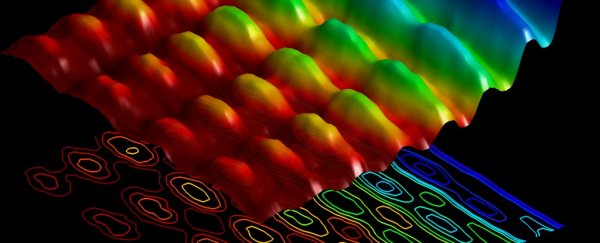Until recently, scientists didn't think it could be done. They thought the fundamental laws of physics would forbid it.
But a persistent group of scientists at the University of Warsaw have now accomplished the impossible: They created a hologram of a solitary particle of light.
This accomplishment is ushering in a new era of quantum holography, which will give scientists a new way of looking at quantum phenomena.
Unlike the photography, holography recreates the spatial structure of objects, giving us their 3D shapes. The technique takes advantage of something called classical interference, which is when two waves meet and form a new wave.
But classical interference is impossible with photons since their phases (a property of waves) are constantly fluctuating. So the Warsaw physics tried to give quantum holograms a taste of their own medicine by using quantum interference, in which photons' wave functions (which have to do with the probability of the particle being in a particular state) interact.
"Wave function is a fundamental concept in quantum mechanics and the core of its most important principles, the Schrödinger equation," Phys.org says.
"In the hands of a skilled physicist, the function could be compared to putty in the hands of a sculptor. When expertly shaped, it can be used to 'mould' a model of a quantum particle system."
So why photons?
While filming the behaviour pairs of photons, Radoslaw Chrapkiewicz and Michal Jachura, two of the researchers, noticed something called two-photon interference. In two-photon interference, pairs of distinguishable photons act randomly when entering a beam splitter (which divides a ray of light).
But non-distinguishable photons exhibit quantum interference, which affects their behaviour. The pairs are always either transmitted or reflected together.
"Following this experiment, we were inspired to ask whether two-photon quantum interference could be used similarly to classical interference in holography in order to use known-state photons to gain further information about unknown-state photon," Chrapkiewicz said.
"Our analysis led us to a surprising conclusion: it turned out that when two photons exhibit quantum interference, the course of this interference depends on the shape of their wavefronts [an imaginary surface joining all adjacent points with the same phase]."
Understanding quantum mechanics
This experiment has huge implications for our understanding of the fundamental laws of quantum mechanics, a field of physics that has been perplexing scientists for more than a century. It allows scientists to gain valuable information about the phase of a photon's wave function.
"Our experiment is one of the first allowing us to directly observe one of the fundamental parameters of photon's wave function - its phase - bringing us a step closer to understanding what the wave function really is," Jachura said.
The researchers hope to apply this method to create holograms of more complex quantum objects, which might have implications that stretch beyond fundamental science into real-world applications.
"All of us - I mean physicists - must first get our heads around this new tool," said Konrad Banaszek, a researcher in the experiment.
"It's likely that real applications of quantum holography won't appear for a few decades yet, but if there's one thing we can be sure of, it's that they will be surprising."
This article was originally published by Business Insider.
More from Business Insider:
